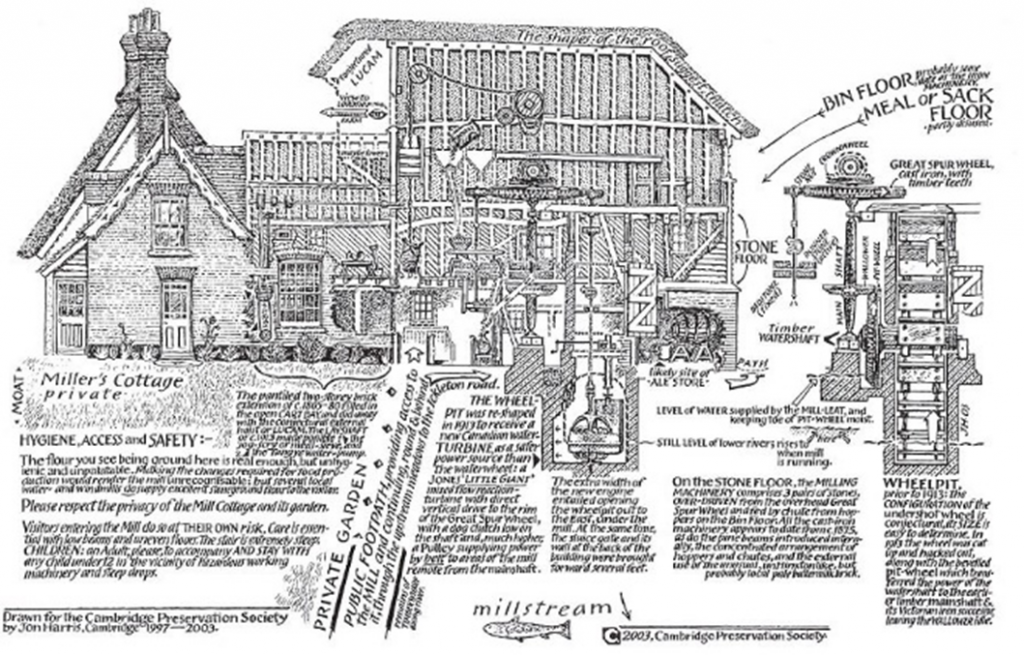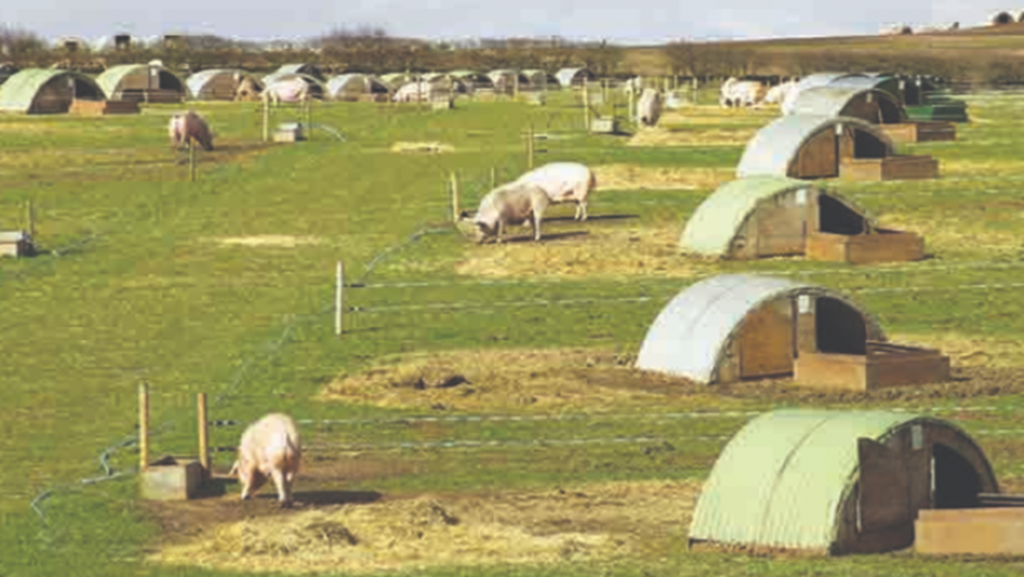April 19th
A visit to East Anglia leads to stories of wind and water mills, plus reports of a few climate-related court proceedings, locally and worldwide.


On Wednesday I was travelling on trains from breakfast ’til supper time, with just a few breaks in between. My journey began in Norwich, after a 5 day trip to Norfolk and Suffolk, where once again it was a case of cold, wet and windy weather … very untypical of that part of the world and unseasonable for mid-April. Sunday brought a most welcome dose of sunshine, when I managed to fit in a long walk with friends, through shoulder-high oil-seed rape. On other days I only had time for a few short running routes, one of which brought me to this disused windmill.
As some of you may remember from past blogs, I have quite an obsession for old mills, especially any that still operate today. It all began in my childhood at our family farm, with a small wind pump bringing water up from a deep aquifer. These days I subscribe to the national Mills Archive, which is run from a beautiful old mansion in Reading. Just recently there has been a fascinating new project there, run by Rachel Riddell, which initially I thought was called ‘Renewable Roots’. But later it seems to have changed to ‘Reading-emPOWERed’
Rather than write it up myself, I am happy that Rachel has provided a link to her newsletters – https://new.millsarchive.org/renewable-roots/ (please note, not all the links are working at the moment) plus the following extra materials, all of which emphasise how close their vision is to our one at Meadow Barns – Learn from the Past to build a Greener Future!



The Mills Archive Trust is a repository for millions of wind and water power records and is based in Central Reading. Their project, “Reading EmPOWERed”, is a 2 year project funded by the National Lottery Heritage Fund. It emphasizes the crucial role of renewable energy in our local, national and international historical and current landscapes. This initiative delves into the transformation of traditional milling methods to contemporary electricity generation, promoting sustainable energy practices.
The project not only explores the historical evolution of wind and waterpower, but also ties these lessons to today’s urgent climate and energy challenges. This makes it a vital resource for teachers, students, and community members interested in environmental sustainability and history. That’s us too!
The project encompasses a variety of initiatives and events aimed at enhancing community involvement and education. We work with the community to interpret the Archive’s renewable energy records in diverse ways, such as workshops with local schools; the production of newsletters (eg. Renewable Roots) and digital content; interactive exhibitions; and talks in renewable energy and historical technologies.
Collaborations with cultural and academic groups help deepen the understanding of the sustainable practices rooted in the past, driving home the importance of these resources in current and future environmental strategies. In essence, “Reading – EmPOWERed” aims to not only educate but also to inspire action towards renewable energy solutions within the community.
Readers, I expect you can understand how heart-warming it is to stumble across another person co-ordinating a team of volunteers and staff, all on the same track. We will be having a joint Zoom next week and I can’t wait!
Back to the Mills in Norfolk, Suffolk and Cambridge
It was interesting to find that the purpose of most of the mills listed on an official Norfolk council site was drainage of dikes. 9 out of the 15 in their list have drainage in the name. Others were for corn milling, sawing timber and – at Reedham Marshes – somehow drove engines, with a steam engine house and diesel sheds.
https://www.norfolk.gov.uk/article/43278/Our-mill-sites
On Monday I was invited to lunch with friends in Bury St Edmunds, which is a location with the earliest recorded windmill in Suffolk, dating back to c1191. So, I checked out what mills there are in the rest of the county as well https://www.visitsuffolk.com/post/5-must-see-mills-in-suffolk
There are different styles of architecture for windmills, of which the most common are the post mill, tower mill and smock mill – this was news to me. Smock mills were invented by the Dutch, Suffolk’s close North Sea neighbours, and were constructed with a timber-framed tower, although the Suffolk construction differs slightly. As in Norfolk, these mills would have been mainly used for the drainage of marsh land.
Although not entirely flat, Suffolk rivers suffer from not having a huge flow of water, hence watermills are much scarcer than windmills. Being somewhat more robust, however, the water examples have survived better than the wind. Throughout the county you may find mills driven by river water, but also a number of tide mills. These would have been used in industry:- for the production of silk, papermaking, oil manufacture, flax spinning as well as traditional corn milling.
It seems to me that Tide Mills offer a definite glimmer of future Climate Hope. As I read of these old types still working e.g. at Woodbridge, it suggests this has potential to develop all around our coastline. And as an extra dimension, perhaps we can abstract sodium from the salt water, for use in sodium ion batteries? The 2 things could link brilliantly together, into new systems of sustainable energy with battery storage. What a lovely thought to share, accompanied by an equally lovely photo below: –

You will find Woodbridge Tide Mill, an iconic building, standing on the banks of the River Deben in this picturesque market town.
Whenever the tides are suitable, the mill breaks into work. It is now a living history museum so you can really see close-up how the wood and metalwork work together with the flow of the water to grind the grain into flour. Milling and turning days are scheduled throughout the summer months, when the mill is open daily until the beginning of October.
Cambridge
Cambridgeshire’s landscape is similar to its neighbours, being very much dominated by wind pumps for drainage, which have kept the Fens from flooding over the years. Today, however, my online source says there is only one of these original wooden drainage mills left and advises to see it at the National Trust’s Wicken Fen. Hang on, I say to myself, don’t you remember when you once visited a wonderful water-driven cornmill at Houghton Mill near Huntingdon – another National Trust property? Now it comes back to me very clearly. I took loads of pictures and film, at the time, but the relevant storage hard drive is not co-operating so unfortunately I cannot share them.
There are plenty more online links about Cambridge mills. I love the look of the Cambridge Museum of Technology with so many options to explore. But be warned that their film is over 40 minutes long; very fascinating, if you can spare the time.
https://www.museumoftechnology.com/news/from-windmill-to-wind-turbine
Two mills are run by Cambridge Past, Present and Future – a charity. Their CEO kindly provided a short statement for us – Both of our mills are operational and can grind corn. We grind corn at Hinxton Watermill when it is opened once a month, for demonstration purposes. List of dates here https://www.cambridgeppf.org/Pages/Events/Category/hinxton-watermill-events
Our windmill is https://www.cambridgeppf.org/Pages/Category/bourn-windmill and dates of openings at https://www.cambridgeppf.org/Pages/Events/Category/bourn-windmill-events
A 3rd National Trust option is the Lode Mill at Anglesey Abbey, which still runs a waterwheel to grind corn and they also sell their flour.
Finally, let me flag up National Mills Weekend on May 11th and 12th. This is the link for East of England, but you will find all the opportunities across the entire UK listed. What a great thing to enjoy on a spring weekend.
https://www.spab.org.uk/content/6-mills-visit-east-england-national-mills-weekend

Court Cases – Norfolk, Denmark and Switzerland
I was staying near a town with a strange name, Wymondham pronounced Windham, and quite by accident saw an article in the Wymondham and Attleborough Mercury, about a man whose clifftop home in Hemsby was demolished by the local council, citing fears of coastal collapse due to erosion. Kevin Jordan is now caught up in a legal challenge, along with other neighbours, who are seeking compensation for the failure of our UK government’s climate change future-proofing plan.
A High Court judge has ordered a judicial review of the National Adaptation Plan following a case led by Friends of the Earth. The two-day hearing will take place on the 18-19th June.
Departing from Norwich on the train to Cambridge, I passed by many acres of land devoted to pig farming. By coincidence, almost immediately, an email dropped into my Inbox about another climate-related court case this time involving pig farmers, in Denmark.

The Danish government is currently giving consideration to imposing CO2 taxes on animal production. As we might anticipate, this idea is strongly opposed by farmers and the related meat processing and export sector. Denmark has more pigs than people! Tens of millions of the animals are killed in Danish slaughterhouses each year, with most of the meat exported to other EU countries.
The Danish Crown group, owned by thousands of livestock farmers, is Europe’s largest meat processing company. On 1st March they were taken to court by campaigners from the Vegetarian Society of Denmark and the Climate Movement Association, which has achieved a limited success, in that Danish Crown have been warned and have rowed back from their previous ‘hogwash!’
The Western High Court agreed the company should not have put stickers on its packaging declaring its pigs were “climate controlled”. Danish Crown acknowledges that they were behind a massive advertising campaign – “Danish pig is more climate-friendly than you think” – that made their climate-damaging products appear greener than they actually are,” says Frederik Roland Sandby, secretary-general of the Climate Movement in Denmark.
The campaigners case referred to Danish Crown’s description, as being committed to sustainability, which they argued is impossible given its carbon-intensive industry. Pork is the third highest animal-based food source of emissions after beef and cow milk, according to climate scientists.
“Pork production is incredibly climate-damaging, not least because of the massive deforestation taking place to feed millions of pigs with soy,” says Rune-Christoffer Dragsdahl, general secretary of the Vegetarian Society of Denmark.
“Instead, we should reduce meat production, plant more trees, and re-establish forests to buy us valuable time to halt the dramatic climate changes we are all facing. I hope that many companies will follow suit and learn from this so that we can have a fair market, where climate-damaging products like pork are not marketed as ‘climate-friendly’.”
MY ADDITIONAL COMMENT – Plant-based bacon can be just as bad for the planet as the real meat.
The foundation for almost all plant-based bacon products is soy. It may be soybeans, tofu, or tempeh, but you’ll find a good number of brands use this as their base. Why? Soy is notorious for being able to imitate both the texture and taste of meat.
Danish Crown are now eating humble-pie 😊 saying “Since the lawsuit was initiated, we have emphasised that it is crucial for us and the rest of the business world to be able to communicate our climate actions, in order to differentiate ourselves and make climate effort a good business – and we still believe this. At the same time, the long and thorough process in the Western High Court has led to both healthy reflections and a useful debate about the boundaries when a company needs to communicate about sustainability.”
It seems inevitable this will only be the start for a growing movement, demanding better behaviour and policing of environmental standards world-wide. Indeed, across the Atlantic, New York State Attorney General Letitia James has initiated a lawsuit against JBS, the world’s largest meat company, for their false climate claims.


Swiss Ladies Court Case
This story has been widely shown on TV, but my source is a Politico EU report which says … the European Court of Human Rights’ (ECHR) shock ruling on climate targets earlier this month could hardly have been more explosive for a British political landscape already gripped by election fever.
In a landmark ruling, Europe’s top human rights court ruled in favour of a group of elderly Swiss women who said their government’s inadequate efforts to combat climate change had violated their human rights. The court effectively concluded that humans have a right to safety from climate catastrophes — a move which immediately established a potent precedent that people living in the nearly 50 nations under the jurisdiction of the court could potentially use to sue their own governments.
The case was brought by about 2,500 women, aged 73 on average, of the Senior Women for Climate Protection. Four of its members complained about the “failings of the Swiss authorities” in terms of climate protection that could “seriously harm” their health. The women said that their age and gender made them particularly vulnerable to the effects of heatwaves, linked to climate change.
It is the first time the powerful ECHR court has ruled on global warming. Their verdict came back saying Switzerland’s efforts to meet its emission reduction targets had been woefully inadequate.

Afterwards Swedish campaigner Greta Thunberg joined activists celebrating at the court in Strasbourg. “We still can’t really believe it. We keep asking our lawyers, ‘is that right?’ Rosemarie Wydler-Walti, one of the leaders of the Swiss women, told Reuters news agency. “And they tell us it’s the most you could have had. The biggest victory possible.”
“This is only the beginning of climate litigation,” said Ms Thunberg. “We have to fight even more, since this is only the beginning. In a climate emergency everything is at stake.”
The Swiss verdict, which cannot be appealed, could compel the government to take greater action on reducing emissions, including revising its 2030 emissions reduction targets to get in line with the Parish Agreement goal of limiting warming to 1.5 degrees Celsius (2.7 degrees Fahrenheit).
Back in the UK this case is already spurring people to hard-hitting comments, on both sides of the political spectrum.
We and others will be integrating this precedent … as we continue to digest the detail of the court’s findings,” said Sam Hunter-Jones, a senior lawyer from the green charity ClientEarth, which currently has a case against the government and has already taken it to court and won before. Translation: expect more litigation.
Jennine Walker, a legal manager at the Good Law Project campaign group, added that the U.K. government “could, in theory, face further legal action.” (Watch out folks, I can imagine myself as part of group action before long!)
On the other side, political figures in the Tory party and beyond (further to the right of the Conservatives) sense an opportunity to link their campaign to leave the European Court of Human Rights with efforts to scrap Britain’s net zero push.





